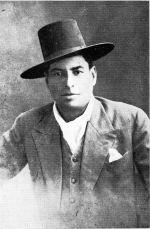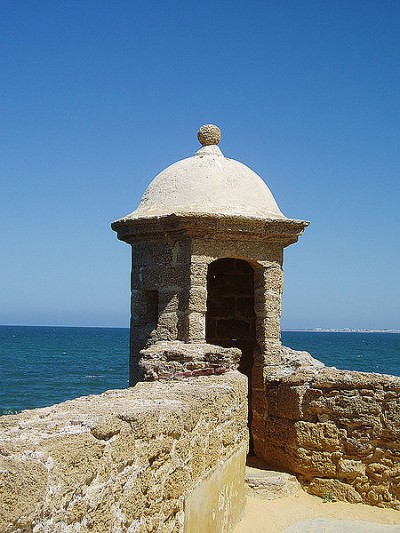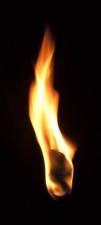
It is said that the singing of Manuel Torre had "black sounds" (sonidos negros), a term apparently used by the Jerez-born singer himself. Upon listening to Torre's recordings, any good aficionado will quickly notice highly personal forms of interpretation, melodic twists, a peculiar resonance... As Juan Talega once said, "things that can't be explained." Even if they can not be explained, the details of Torre's singing can be described. What is much more difficult to explain is the absence of these details in the singing of artists present and past, even among Torre's many admirers.
The black sound that is the subject of this study is produced by the major second degree in certain parts of certain cantes that are associated with the Andalusian cadence. This tone is heard in the following cantes, most of which were recorded by Torre:

In most of these cantes, the major second degree is one of the defining elements of the style, meaning that singers usually interpret the cantes just as they are heard in the following recordings. However, the tone is a peculiar variation in the siguiriyas of Manuel Molina and Manuel Torre and the cantes levantinos indicated below. Although the same tone is heard in all of these cantes, the harmonic implications may vary from one cante to another (it sounds more or less black). The origins of the cantes included in this study are spread across southern Andalusia. Let us begin our journey on the shores of the Atlantic, in Cádiz.

The tone is most easily perceived in tientos in a cante that is sung in several different ways and that remains very popular today. In view of the abundance of this cante among the oldest recordings of flamenco, in which the guitarists unhesitatingly accompany with the emphasized tone or the V7 chord, it seems that this cante was very well known in the first decade of the 20th century. The major second degree marks an abrupt departure of the cante from its harmonic structure.
Sebastián el Pena in 1908 with Joaquín el hijo del Ciego. The major second degree is heard at the end of the first sung line.
Y Díos mío ¿qué me faltaba?
y era la luz del entendimiento
cuando de ti me acordaba
Manuel Torre in 1909 with Juan Gandulla. The tone appears at the end of the first sung line.
Dame Dios mío paciencia
que para bregar con esta serranita tan mala
me falta la resistencia
El Garrido de Jerez in 1910 with Román García. The major second degree is heard at the end of the fifth sung line. The verse, which is number 2869 in the collection of Rodríguez Marín, is often shortened and sung por bulerías, starting with "Cuando paso por tu puerta," as heard in the recordings of Fernando Terremoto and others.
Cada vez que paso y miro
los lumbrales de tu puerta
cada vez que paso y miro
los lumbrales de tu puerta
los lumbrales de tu puerta
me arrodillo y los venero
como si fuera una iglesia
cada vez que paso y miro
los lumbrales de tu puerta
Pastora Pavón in 1910 with Ramón Montoya. Pastora sings the major second degree at the end of the fifth sung line.
La luz del entendimiento
tú me has estado dando a comprender
La luz del entendimiento
tú me has estado dando a comprender
tú me estás dando a comprender
que no hay fatiga más grande
que aquél que quiere y no puede
Cojo de Málaga in 1923 with Borrull padre. As we shall see throughout this study, Joaquín Vargas Soto "Cojo de Málaga" sang this tone masterfully in several different styles. In this tiento, the tone appears at the end of the third sung line. The verse is number 5502 from the collection of Rodríguez Marín: "Hasta la cama en que duermo / Tiene lástima de mí, / Al ver que suspiro y lloro / Cuando me acuerdo de tí." Number 5524 from the same collection is a variation: "Jasta las piedras que piso / Tienen lástima de mí, / En ber que suspiro y yoro / Cuando m' acuerdo de tí."
Las sabanitas de mi cama
tienen lástima de mí
tienen lástima de mí
en ver lo que suspiro y lloro
cuando me acuerdo de ti
Other early recordings of this cante include two more versions of Manuel Torre in 1909 with Juan Gandulla, two versions of Manuel Escacena in 1908 with Román García and in 1914 with Pepito Cilera, and one version of Manuel Pavón in 1914 with Ramón Montoya. Pastora recorded it at least five more times with as many guitarists.

Tomás Pavón in 1947. Another version of the same cante. As in the preceding version, Tomás sings the major second degree at the end of the lines of verse in order to reestablish the tonality.
Ay ven acá tú mujer del mundo
convéncete a la razón
que no hay un hombre en el mundo
que sea fijo como el reloj
El Gloria in 1929. This tonás is normally sung at the end of a series. The peculiar phrase heard at the beginning of the second sung line ("que Dios") ends on the major second degree.
Y si no es verdad
que Dios me mande la muerte
si me la quiere mandar
Antonio Mairena in 1954. Another style of toná that is not as well known as the others. The fifth sung line ("yo no") has the same phrase indicated above.
Ay soy gerá en el vestir
y calorró de nacimiento
yo soy gerá en el vestir
calorró de nacimiento
yo no quiero ser gerá
con ser caló estoy contento
It is worth noting that the major second degree is a natural part of cantes that are based on the major scale and that in such cases the tone does not cause any particular impression. These cantes include cantiñas, siguiriyas cabales, tonás and others that we are not going to study in depth. The blackness of tonás is produced by other notes such as the minor second degree and its contrast with the underlying major key. In other words, the tone sounds black when the major second degree draws the cante away from its tonality, and in tonás and other cantes, the tone reestablishes the tonality (as clearly heard in the toná sung by el Gloria and Tomás Pavón).

Frasco el Colorao: This Triana-based style has the greatest potential for the blackness of the major second degree due to its anguished succession of ascents and descents between the tonic and the fourth degree and incursions into neighboring tones, characteristics that are highly reminiscent of the toná interpreted by el Gloria and Tomás Pavón. Nonetheless, few singers make full use of said potential because the melodies of this cante and related cantes tend to fall into a rather simple arrangement in which the major second degree creates dissonance that resolves to the third degree. For this reason, in some versions of this cante and other related cantes such as those of Curro Durse and Manuel Torre's "Santiago y Santa Ana," the sound of the major second degree is less black. The same thing happens in some styles of soleá and in the cantes levantinos.
Tomás Pavón in 1948 with Melchor. A masterpiece of flamenco art. The winding melodic path between the fourth degree and the tonic includes the major and minor second degrees, creating the impression of a violent crashing of waves of confused desperation. The cante starts with a descent from the fourth degree to the third and to the major second (Dios), followed by another descent from the third degree to the tonic by way of the minor second degree (mandó). Tomás ends this first sung line with both degrees in the remaining vowels: the minor second degree in "remedio," the major second in "remedio" and the minor second in "remedio." The pattern is repeated in the second sung line, which ends with the prolongation of the third degree. In the long line of verse, both degrees are heard in the first syllable of "compañera." As a result of Tomás' extraordinary technique and artistic sense, this version remains head and shoulders above all others. Melchor accompanies with the V7 chord in the first sung line.
Y Dios mandó el remedio
Dios mandó el remedio
para este mal mío y el de mi compañera y
que no lo hay ni lo encuentro
Rafael Romero in 1968 with Antonio Arenas. The major second degree is heard at the end of the first (mía) and second (duraré) sung lines and in the long line of verse (mundo).
Aaayyy
Si esta pena mía
mucho me durare
por todas las murallas que en el mundo hubiera y
que yo las derribare
Manuel Molina 1: In this Jerez-based style, the major second degree is a peculiar variation recorded by Torre and just a few of his followers. Like the preceding Triana-based style, of which this style is considered to be a derivative, there is a series of ascents and descents between the fourth degree and the tonic, although the melodies are different (for example, at the end of the second line of verse). It must also be observed that in these examples of the Triana-based style, the major second degree appears before the minor second degree, and in this Jerez-based style, the degrees are arranged in reverse order, with the minor second degree being sung first and the major second degree afterward.
Tomás Pavón in 1928 with Ricardo. The major second degree is heard in the long line of verse at the beginning of the word "canela."
A clavito
a clavito y canelita
me hueles tú a mí
la que no huele a clavo y canela
no sabe distinguir
Manuel Torre in 1929 with Borrull hijo. Outstanding recreation of this style. He sings the major second degree in the last sung line ("pidiendo"), constituting a variation at the end of the cante (compare the second and fourth lines of verse).
Te fuiste de
de mi vera te fuiste
sin apelación
ahora te veo
ahora te veo que te hincas de rodillas
pidiendo el perdón
Pastora Pavón in 1933 with Antonio Moreno. This version may be the best example of the tremendous potential of the major second degree. Pastora keeps her voice low and in tight control (the key is about five semitones lower than her other siguiriyas), creating an eerie atmosphere that becomes particularly unsettling with the major second degree in the second ("hazme") and fourth ("la") sung lines. It is worth noting that, in both cases, Pastora sings the tone in the preceding words. Notice that three melodic upturns are heard in "los" in the first line of verse and "decirte" in the third and that the tone is heard briefly after the third upturn. In his 1977 album Despegando, Enrique Morente recorded a version of this verse with some of the details heard in Pastora's singing.
Mírame
mírame a los ojos
hazme usted el favor
que mis ojitos
que mis ojitos camelan decirte
la verdad de todo
Manuel Torre 1: As in the preceding style, of which this cante is a derivative, the major second degree is a peculiar variation. The shadow of Manuel Torre seems to emerge in the versions of Tomás and tío Mollino. However, it must be observed that Torre sings the major second degree at the beginning of the last line of verse, and in the versions below the tone is heard at the end of the long line of verse.
Tomás Pavón in 1928 with Ricardo. The major second degree is heard at the end of the long line of verse ("corazón").
Te se logró a ti el gusto
te se logró el gusto
yo voy a vestir
yo voy a vestir a mi corazón
de un negrito luto
yo voy a vestir a mi corazón
de un negrito luto
Tío Mollino in 1989 with Andrés Rodríguez. Manuel Arroyo Jiménez was born in Algeciras and was a distant relative of Manuel Torre. The major second degree is heard clearly in the last of the three vocalizations in the long line of verse ("llamas").
Me voy quemando
en llamas candela
como me quemo yo me quemaba en llamas
paso entre paso
El Fillo 2: The major second degree is heard in the middle and at the end of the first sung line.
Antonio Mairena in 1959 with Manuel Morao. The tone is heard in "huertas" and "Murcia."
Ay de las huertas de Murcia
yo vengo señores
y así le traigo a la madre de mi alma
ramitos de flores
Juan Talega in 196? with Diego de El Gastor. The tone is heard in "fatigas" and "dieron."
Fatigas me dieron
ganas de llorar
cuando la vi en el vaporcito
la máquina andar
Manuel Moneo with Diego Amaya. The tone is heard in "pegó."
Quién pegó
quién pegó aquel tirito
que en mi puerta dio
que los lumbrales madre de la puerta
me los aderribó
Other styles: As indicated in the text on the siguiriya of Frasco el Colorao, the major second degree sometimes produces less blackness because its tension resolves to the third degree (it might be said that it "sounds major").
El Carbonerillo in 1932 with Ricardo. The style is Curro Durse 2.
Ay
Esos dientes blancos
esos ojos negros
se parecía a la Virgen del Valle
la que está en San Telmo
Antonio Chacón in 1928 with Ramón Montoya. The style is Curro Durse 3.
Ayay
Y era una madrugada
de Santiago y santa Ana ay
santa Ana ayay yy yy
a eso de la una
las fatiguitas grandes diñaron ay
a mi madre Curra
Manuel Torre in 1929 with Borrull hijo. The style is Manuel Torre 3.
Era un día señalado
de Santiago y santa Ana ayayayayay
de Santiago y santa Ana ayay
le rogué yo a Dios
que le aliviara a mi madre las ducas
de su corazón

Manuel Torre in 1922 with Hijo de Salvador. The tone is in the second sung line (no, ley).
Que te den los sacramentos
porque no le tienes ley
ni a la camisa del cuerpo
ven acá mala serrana
que te den los sacramentos
Manuel Torre in 1922 with Hijo de Salvador. The tone is heard in the third (in the "ay") and fifth (delante, crucifijo) sung lines.
Yo dije que me echaría
dije yo que me echaría
ay hábito de San Antonio
si esta mujer me quería
delante de un crucifijo
yo dije que me echaría
José Yllanda 2. In this hybrid style, the last two lines of verse are sung in the style of la Serneta 3.
Rafael Romero in 1967 with Antonio Arenas. The tone is heard in the third (adjudicando) and fourth (casamiento) sung lines.
Que me tiro a un pozo por Dios
que me tiro a un pozo que me-
-e están adjudicando
un casamiento forzoso
que me están adjudicando
un casamiento forzoso

The major second degree is also heard at the end of the first sung line of the bulería corta and at the beginning of the second half of a cante attributed to tío Pacote.
Bulería corta. Recordings of flamenco show that, until the late 1960s, very few guitarists accompanied this cante with the V7 chord (E7 por medio). Melchor de Marchena made excellent use of said chord in his accompaniment of siguiriyas but rarely in the bulería corta. The same can be said of Niño Ricardo, who apparently accompanied this cante with said chord only in two of his last recordings (both from 1969, accompanying Curro Malena and, along with Paco de Lucía, el Lebrijano). The late development of the accompaniment of this cante is puzzling, especially in view of the fact that, until just a few decades ago, singers insisted on singing the major second degree and their guitarists insisted on accompanying with chords that do not include the tone. The reason for this may be that early guitarists associated the use of the V7 chord with tientos, as seen at the beginning of this study, or simply because the cante offers little space to work the chord into the accompaniment.
Cojo de Málaga in 1921 with Borrull hijo. The major second degree is heard in "serrana." It sounds like Borrull accompanies with the V7 chord in the first half of the second line of verse.
Y los ojos de mi serrana
y si no los veo esta noche
los veo por la mañana
Cojo de Málaga in 1921 with Borrull hijo. The same cante por bulería. The tone is heard at the end of the lengthening of the word "den."
Puñaladitas le den
y a quien tiene mala lengua
y naquera lo que no es
y a quien tiene mala lengua
y habla lo que no es
Manuel Torre in 1928 with Borrull hijo. The tone is heard in the word "yo."
Lo que te camelo yo
te tengo retratadita
presente en mi corazón
Soleá del tío Pacote. In this variation of the bulería larga, the major second degree is heard at the beginning of the second half of the cante. This cante has points in common with the hybrid soleá José Yllanda 2.
El Barullo in 1995. The tone is heard in the third sung line in the word "casita."
Y el que anda mal acaba
y el que anda mal acaba
casita de jabonero
y el que no cae resbala

Pastora Pavón in 1929 with Ramón Montoya. It seems that Pastora was the only artist to record this variation of her friend Manuel Torre. In this malagueña de Chacón, the tone is heard after the last sung line. As in the preceding recording, the cante is accompanied with the toque de Levante (tarantas key). Listen to the last sung line.
Del convento las campanas
si preguntan por quién doblan
del convento las campanas
diles que doblando están
y a mis muertas esperanzas
y a mis muertas esperanzas
Pastora Pavón in 1950 with Melchor de Marchena. The verse sung by Pastora in this malagueña de la Trini has only four lines, as does the preceding verse. It is number 5573 in the collection of Rodríquez Marín: "Ar barrio de la Bitoria / Se l' han corrío los belos; / Quiero entrar y no me dejan; / Quiero salir y no pueo." Listen to the last sung line.
Se le han corrido los velos
al barrio de la Victoria
se le han corrido los velos
quiero entrar y no me dejan
quiero salir y no puedo
quiero salir y no puedo

The major second degree and neighboring tones in the arc sung by Torre in his malagueña are found in abundance in the recordings of Joaquín Vargas Soto "el Cojo de Málaga." The reported friendship of these artists may have involved mutual influence as deduced from Vargas' many recordings of the bulería corta (he was also the first to record the siguiriya of Paco la Luz) and Torre's assimilation of what may be echoes of the cantes mineros at the end of his malagueña. Although the major second degree is not heard in the verse of the tarantos recorded by Torre, the tone is clearly observed in the initial vocalization, as we shall see in the following section. It is worth noting that, in addition to those indicated below, Cojo de Málaga made many more recordings that feature the major second degree.
Cojo de Málaga in 1921 with Borrull hijo. In this style 2 of the levantica del Cojo de Málaga, the ends of some of the sung lines feature the major second degree in the major-sounding context referred to elsewhere in this document. The tone is heard in the first ("comprado"), second (after "Carbonera") and fifth ("lado") sung lines. However, after the last word of the last line of verse, the black sound appears in the vocalization that falls to the major second degree and again to the major seventh. Listen to the last sung line.
Que mira lo que te he comprado
que vengo de la mina de La Carbonera
que mira lo que te he comprado
unas botas de cartera
que con los botones a un lado
te las pones cuando quieras
In this recording of Sabicas made in 1931, the violinist Rafael de La Unión interprets the melody of the levantica del Cojo de Málaga. Listen to the end.
Cojo de Málaga in 1924 with Borrull padre. In this minera de Pedro el Morato, the tone is heard in the initial vocalization and, with the same music, in the last sung line.
Ay viva Lorca y viva Murcia
aay y que viva Lorca y viva Murcia
y viva Málaga la bella
y para puerto bonito
Barcelona y Cartagena
aay que viva Lorca y viva Murcia
Cojo de Málaga in 1923 with Borrull padre. In this taranto de Pedro el Morato, Cojo de Málaga makes full use of the dissonance of the major second degree, which is heard in several syllables in the last sung line.
Ay el corazón
aay el corazón me se parte
cuando pienso en tus partidas
aay cuando te tengo delante
todo lo malo se me olvida
aayyy y tengo que perdonarte (ay y que)
Manuel Escacena in 1928 with Borrull hijo. The Seville-born singer ends this minera de Basilio with vocalization in which the major and minor second degrees are clearly audible. Listen to the last sung line.
Decían con salero y garbo
ay todas las muchachas del pueblo de Níjar
que dicen con salero y garbo
la cuenta está clara y fija
que el que se arrima a buen árbol
ay qué buena sombra le cobija (siempre le cobija)
As indicated in the minera de Pedro el Morato interpreted by Cojo de Málaga, the major second degree sometimes appears in the initial vocalization. It is a strategy often used by singers, as the distinction between the major and minor second degrees is a discreet means of warming up the voice.